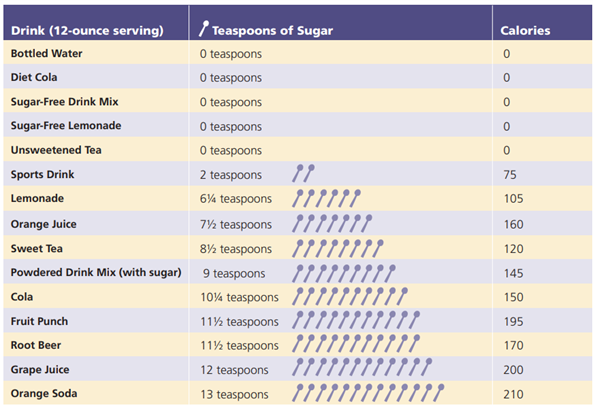Hidden Sugars: Tips to Making Healthier Choices for You and Your Child
Childhood Obesity and Hidden Sugars in Food - On Call for All Kids
How much sugar should kids have daily?
The American Academy of Pediatrics (AAP) currently recommends that children 2-18 years of age have a maximum of 6 teaspoons, or 25 grams of sugar per day. This often surprises parents and families as it is a very small amount of sugar overall. If you consider that one can (8-10 ounces) of soft drink or orange juice can have anywhere from 35 to 40 grams, you can see how quickly we start to add on more sugar and, unfortunately, more pounds than are needed. To see how quickly sugar adds up, look below to see how many teaspoons of sugar are in most beverages.
Sugar amounts in popular beverages

Adapted from https://www.cdc.gov/healthyweight/healthy_eating/drinks.html
Why do you think it’s so difficult for us to know how much sugar we really eat daily?
There are many reasons why it is difficult to know how much sugar we eat per day. First, is that we often expect for sugar to look the way it looks when we sweeten our tea or coffee—a powder or granule. That’s often not the case. In fact, the majority of foods that we purchase or make are fortified or supplemented with sugar, and you would only know by reading a food label.
What are some of the most common foods to avoid that have hidden sugars?
There are so many foods that are often marketed as “healthy” for kids and families that are unfortunately not great for maintaining a healthy weight or for overall health.
Top Foods with Hidden Sugars:
-
Sports drinks and energy drinks
-
100% juice drinks
-
Breads and cereals
-
Yogurts and flavored milks
-
Most breakfast foods (cereals, pancakes, waffles, croissants)
What can parents and kids do to be more aware of and reduce how many hidden sugars they eat?
-
If you’re going to have a beverage (juice, soda, sports drink), “Rethink your Drink!” by watering it down/diluting it with water. Using flavored water options or sparkling water options can be very helpful.
-
When it comes to breads and cereals, look for whole wheat options. The more fiber the food has, the better it is for you and the less health effect of the sugar it contains.
-
For yogurts, we recommend looking for the plain yogurt options and adding fresh fruit or small amounts of honey to the portion. Remember that a healthy portion for most children is often about the amount of yogurt that fits in their hand, so make sure you’re not giving them too large of a portion. Also, milk is already sweet and adding more sweeteners or flavor is really just unnecessary calories.
-
For breakfast, think about options that include unprocessed foods: Eggs, fruit, vegetables and lean meats (turkey bacon) can really fill you up in a healthy way. If you’re going to choose pancakes or waffles, think about your portions and think about it as “extra” vs. the central part of your meal.
Many parents have questions about sugar substitutes or zero sugar options. Are these healthy?
Sugar substitutes have both advantages and disadvantages when introduced into our diets. Interestingly, they have been hard to study because each of these substitutes whether they are synthetic (saccharides) or natural (stevia) are metabolized in different ways, so it has been hard to compare “apples to apples” in most clinical trials. In general, the more we avoid synthetic substances, the healthier we are. In addition, there have been studies to suggest that artificial sweeteners can cause increased appetite, increased insulin response (and therefore increase risk for diabetes) and in some cases, increased risk for cancer. Having said that, I have had several patients in which a transition to artificial sweeteners has led to improved health in reducing their intake of high-fructose corn syrup, which had a much more detrimental effect on health and therefore, may be a way of gradually improving how much overall sugar someone is taking in.


